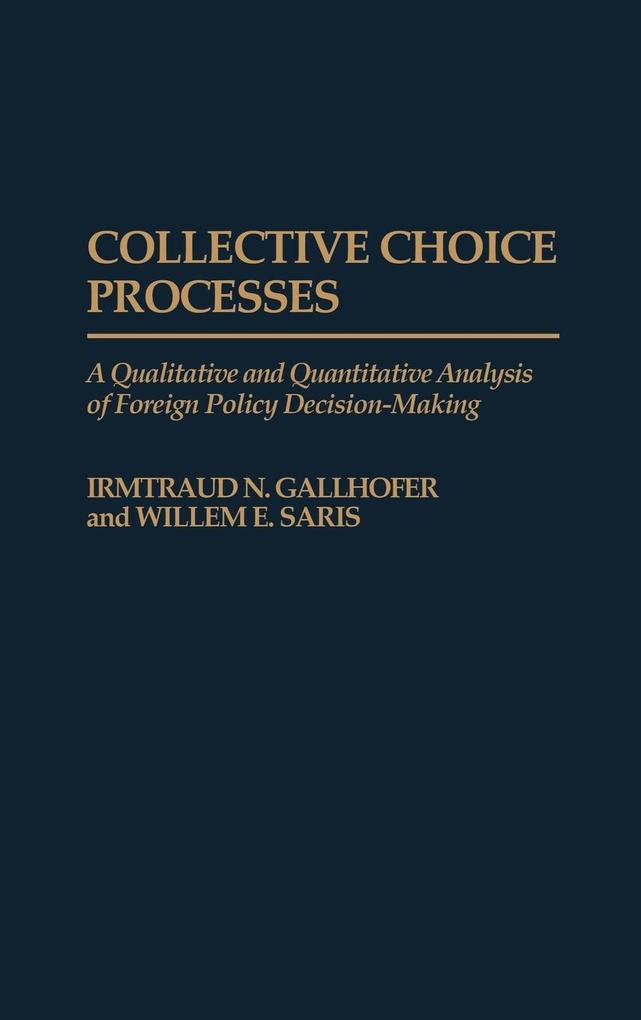
Zustellung: Mo, 21.07. - Do, 24.07.
Versand in 7 Tagen
VersandkostenfreiBestellen & in Filiale abholen:
Gallhofer and Saris examine the collective choice processes in different decision-making units leading to World Wars I and II as well as the Cuban Missile Crisis, colonial wars, and to major foreign policy decisions of a European government after World War II. In the unit relating to the European government, they find strong evidence for consensual decision-making. But when disagreements occurred among the participants, alternative procedures were employed, such as postponements in order to search for additional information, shifts from argumentation to find a compromise, and change from consensus to majority decision-making. How quickly these shifts were made depended on the group norms.
This book provides a theoretical framework to understand how different foreign-policy decision-making units or groups arrive at a collective choice. The qualitative and quantitative studies presented here are based on written records and deal with the choice process of four different decision-making units in situations that pertain to important foreign policy decisions. Germany's decision-making process under Hitler to initiate World War II exemplifies a group with a leader who is insensitive to advice, making the decisions himself and using the group only for acclamation. Kennedy's decision-making during the Cuban Missile Crisis is very different, as it shows a leader sensitive to advice where the group has the task of presenting different options and their consequences. The Austro-Hungarian cabinet's decision to initiate World War I exemplifies a homogeneous group with a dissenter, although it arrived at a collective decision quite quickly using persuasion, compromise, and some coercion. The bulk of the study deals with a heterogeneous unit in a great variety of decision situations, because most Western European governments are of this type. Where there is extreme conflict and time pressure, consensual decision-making is abandoned and a majority choice is hammered out.
As the first systematic documented study of collective decision-making, as it pertains to different decision units, this book will be of considerable importance to scholars and researchers investigating the decision-making process in government and international affairs.
This book provides a theoretical framework to understand how different foreign-policy decision-making units or groups arrive at a collective choice. The qualitative and quantitative studies presented here are based on written records and deal with the choice process of four different decision-making units in situations that pertain to important foreign policy decisions. Germany's decision-making process under Hitler to initiate World War II exemplifies a group with a leader who is insensitive to advice, making the decisions himself and using the group only for acclamation. Kennedy's decision-making during the Cuban Missile Crisis is very different, as it shows a leader sensitive to advice where the group has the task of presenting different options and their consequences. The Austro-Hungarian cabinet's decision to initiate World War I exemplifies a homogeneous group with a dissenter, although it arrived at a collective decision quite quickly using persuasion, compromise, and some coercion. The bulk of the study deals with a heterogeneous unit in a great variety of decision situations, because most Western European governments are of this type. Where there is extreme conflict and time pressure, consensual decision-making is abandoned and a majority choice is hammered out.
As the first systematic documented study of collective decision-making, as it pertains to different decision units, this book will be of considerable importance to scholars and researchers investigating the decision-making process in government and international affairs.
Inhaltsverzeichnis
Introduction
A Qualitative Study of Collective Decision-Making Processes
Theoretical Frameworks for Group Decision-Making in the Context of National Government
Theoretical Framework Used in This Book
Methodology
Germany's Decision to Initiate World War II
The World at the Brink of a Nuclear War: The U. S.' Decision to Avoid a Nuclear War, October 1962
The Austro-Hungarian Cabinet Decision to Initiate World War I
The Dutch Cabinet Decision to Take Military Action in Indonesia, Autumn 1948: Consensual Decision-Making in a Heterogeneous Group
The Dutch Cabinet Decision to Carry Out Military Action in Indonesia, December 1948: A Cabinet on the Brink of Tendering Its Resignation
The Practice of Collective Choice
A Quantitative Study of Collective Decision-Making by a Heterogeneous Group
The Study of Decision-Making Processes
The Decision-Making Process Results
Preference Aggregation Rules
References
Subject Index
Name Index
Index
A Qualitative Study of Collective Decision-Making Processes
Theoretical Frameworks for Group Decision-Making in the Context of National Government
Theoretical Framework Used in This Book
Methodology
Germany's Decision to Initiate World War II
The World at the Brink of a Nuclear War: The U. S.' Decision to Avoid a Nuclear War, October 1962
The Austro-Hungarian Cabinet Decision to Initiate World War I
The Dutch Cabinet Decision to Take Military Action in Indonesia, Autumn 1948: Consensual Decision-Making in a Heterogeneous Group
The Dutch Cabinet Decision to Carry Out Military Action in Indonesia, December 1948: A Cabinet on the Brink of Tendering Its Resignation
The Practice of Collective Choice
A Quantitative Study of Collective Decision-Making by a Heterogeneous Group
The Study of Decision-Making Processes
The Decision-Making Process Results
Preference Aggregation Rules
References
Subject Index
Name Index
Index
Produktdetails
Erscheinungsdatum
30. November 1997
Sprache
englisch
Seitenanzahl
224
Autor/Autorin
Irmtraud N. Gallhofer, Willem E. Saris
Verlag/Hersteller
Produktart
gebunden
Gewicht
521 g
Größe (L/B/H)
235/157/18 mm
ISBN
9780275960292
Entdecken Sie mehr
Pressestimmen
"This work is a pioneering one, which opens up qualitative and quantitative lines of inquiry likely to enable us in the future to identify the ways in which collective decision-making develops once the relationships between the members of the decision-making body are known."-J. Blondel Visiting Professor, University of Siena
Bewertungen
0 Bewertungen
Es wurden noch keine Bewertungen abgegeben. Schreiben Sie die erste Bewertung zu "Collective Choice Processes" und helfen Sie damit anderen bei der Kaufentscheidung.









